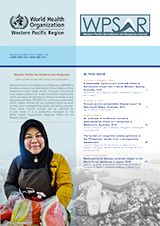An outbreak of foodborne norovirus gastroenteritis linked to a restaurant in Melbourne, Australia, 2014
DOI:
https://doi.org/10.5365/wpsar.2017.8.1.008Abstract
Introduction: In May 2014 an outbreak of norovirus occurred among patrons of a restaurant in Melbourne, Australia. Investigations were conducted to identify the infectious agent, mode of transmission and source of illness, and to implement controls to prevent further transmission.
Methods: A retrospective case-control study was conducted to test the hypothesis that food served at the restaurant between 9 and 15 May 2014 was the vehicle for infection. A structured questionnaire was used to collect demographic, illness and food exposure data from study participants. To ascertain whether any food handlers had experienced gastroenteritis symptoms and were a possible source of infection, investigators contacted and interviewed staff who had worked at the restaurant between 9 and 16 May 2014.
Results: Forty-six cases (including 16 laboratory-confirmed cases of norovirus) and 49 controls were interviewed and enrolled in the study. Results of the analysis revealed a statistically significant association with illness and consumption of grain salad (OR: 21.6, 95% CI: 1.8–252.7, P = 0.015) and beetroot dip (OR: 22.4, 95% CI: 1.9–267.0, P = 0.014). An interviewed staff member who reported an onset of acute gastrointestinal illness on 12 May 2014 had prepared salads on the day of onset and the previous two days.
Discussion: The outbreak was likely caused by person-to-food-to-person transmission. The outbreak emphasizes the importance of the exclusion of symptomatic food handlers and strict hand hygiene practices in the food service industry to prevent contamination of ready-to-eat foods and the kitchen environment.
References
Ahmed SM, Hall AJ, Robinson AE, Verhoef L, Premkumar P, Parashar UD, et al. Global prevalence of norovirus in cases of gastroenteritis: a systematic review and meta-analysis. Lancet Infect Dis. 2014;14(8):725-30.
Robilotti E, Deresinski S, Pinsky BA. Norovirus. Clin Microbiol Rev. 2015;28(1):134-64.
Patel MM, Hall AJ, Vinje J, Parashar UD. Noroviruses: a comprehensive review. J Clin Virol. 2009;44(1):1-8.
Matthews JE, Dickey BW, Miller RD, Felzer JR, Dawson BP, Lee AS, et al. The epidemiology of published norovirus outbreaks: a review of risk factors associated with attack rate and genogroup. Epidemiol Infect. 2012;140(7):1161-72.
Atmar RL, Opekun AR, Gilger MA, Estes MK, Crawford SE, Neill FH, et al. Norwalk virus shedding after experimental human infection. Emerg Infect Dis. 2008;14(10):1553-7.
Rockx B, Wit Md, Vennema H, Vinjé J, Bruin Ed, Duynhoven Yv, et al. Natural History of Human Calicivirus Infection: A Prospective Cohort Study. Clin Infect Dis. 2002;35(3):246-53.
Teunis PFM, Sukhrie FHA, Vennema H, Bogerman J, Beersma MFC, Koopmans MPG. Shedding of norovirus in symptomatic and asymptomatic infections. Epidemiol Infect. 2015;143(8):1710-7.
Ozawa K, Oka T, Takeda N, Hansman GS. Norovirus Infections in Symptomatic and Asymptomatic Food Handlers in Japan. J Clin Microbiol. 2007;45(12):3996-4005.
Maritschnik S, Kanitz EE, Simons E, Hohne M, Neumann H, Allerberger F, et al. A Food Handler-Associated, Foodborne Norovirus GII.4 Sydney 2012-Outbreak Following a Wedding Dinner, Austria, October 2012. Food Environ Virol. 2013.
Friedman DS, Heisey-Grove D, Argyros F, Berl E, Nsubuga J, Stiles T, et al. An outbreak of norovirus gastroenteritis associated with wedding cakes. Epidemiol Infect. 2005;133(6):1057-63.
Mayet A, Andreo V, Bedubourg G, Victorion S, Plantec J, Soullie B, et al. Food-borne outbreak of norovirus infection in a French military parachuting unit, April 2011. Euro Surveill. 2011;16(30).
Chen M-Y, Chen W-C, Chen P-C, Hsu S-W, Lo Y-C. An outbreak of norovirus gastroenteritis associated with asymptomatic food handlers in Kinmen, Taiwan. BMC Public Health. 2016;16(1):372.
Nicolay N, McDermott R, Kelly M, Gorby M, Prendergast T, Tuite G, et al. Potential role of asymptomatic kitchen food handlers during a food-borne outbreak of norovirus infection, Dublin, Ireland, March 2009. Euro Surveill. 2011;16(30).
Boxman I, Dijkman R, Verhoef L, Maat A, van Dijk G, Vennema H, et al. Norovirus on Swabs Taken from Hands Illustrate Route of Transmission: A Case Study. J Food Prot. 2009;72(8):1753-5.
Stals A, Baert L, De Keuckelaere A, Van Coillie E, Uyttendaele M. Evaluation of a norovirus detection methodology for ready-to-eat foods. Int J Food Microbiol. 2011;145(2):420-5.
Bruggink LD, Dunbar NL, Catton MG, Marshall JA. Norovirus genotype diversity associated with gastroenteritis outbreaks in Victoria in 2013.Communicable Disease Intelligence Quarterly Report 2015;39(1):34-41
Food Standards Australia New Zealand. Australia New Zealand Food Standards Code. Standard 3 2 2 - Food safety practices and general requirements. Canberra, A.C.T: Food Standards Australia New Zealand; 2016.

